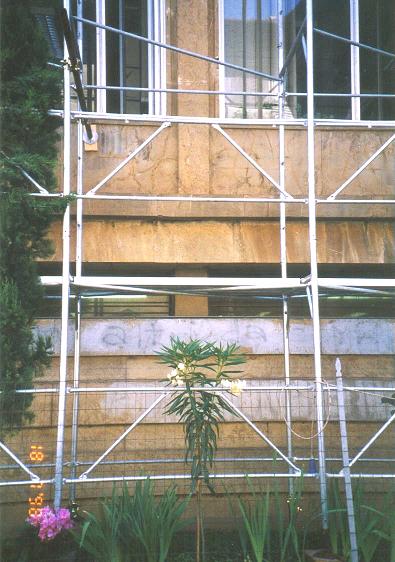Bracing systems of scaffolding structures
Scaffolding structures are temporary structures that are an essential part of the construction process. Scaffolding imposes certain design restrictions that can be ignored in the design of other structures. For example, scaffolding structures must be easily assembled and taken apart, and the components should also be relatively light to permit construction workers to handle them. Although scaffolding structures are light and temporary in the majority of cases, their design should be taken seriously. The concept of direct force paths and the five criteria are applicable to scaffolding structures.
1. The collapse of a scaffolding structure

Fig. 8-9: Collapse of a scaffolding structure (Courtesy of Mr. J Anderson)
The scaffolding structure shown in Fig. 8-9 collapsed in 1993 [8.9], although no specific explanation was given. Using the concept of direct force paths and the understanding gained from the previous examples, the cause of the incident may be explained. It can be seen that in this scaffolding structure no diagonal (bracing) members were provided, i.e. no direct force paths were provided. The scaffolding structure worked as an unbraced frame structure, and the lateral loads, such as wind loads, on the structure were transmitted to its supports through bending of the slender scaffolding members. The structure did not have enough lateral stiffness and collapsed under wind loads only.
2. Some bracing systems used for scaffolding structures


Fig. 8-10: Inefficient bracing systems for scaffolding structures
For the convenience of erection of the scaffolding structures shown in Fig. 8-10, standard units were used. The unit shown in Fig. 8-10a consists of two horizontal members, two vertical members and two short bracing members. The unit is useful for transmitting the vertical loads applied to the top horizontal member to the vertical members that support the unit at its two ends. The unit is equivalent to a thick beam in the structure and the scaffolding structure becomes a deep beam and slender column system. The diagonal members used in the structure do not provide the force paths to transmit the lateral loads on the structure from the top to the bottom of the structure and do not follow the basic criteria for arranging bracing members. Therefore it can be seen that the scaffolding structure has a relatively low lateral stiffness based on the first concept of direct force paths.
Bracing members are also provided in the scaffolding structure shown in Fig. 8-10b. However, these bracing members are linked in the horizontal direction but not connected from the top to the bottom of the structure, and do not create direct force paths. Therefore, without any calculation, it can be judged that the scaffolding structure possesses a relatively low lateral stiffness.
